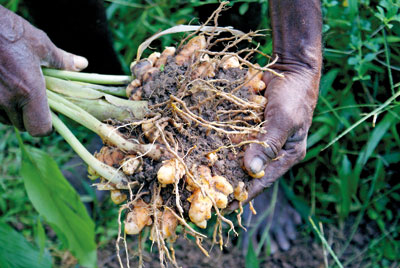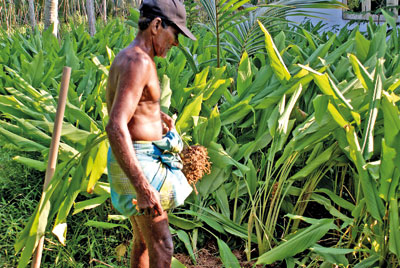News
Where has all the turmeric gone?
- What’s available goes at an exorbitant price
- Spice sellers and processers warn shortage will worsen, blame govt. move to ban turmeric import along with other non-essential goods before fixing the retail price
- It will be one year before the next batch of domestic crop is available, which is nowhere close to meeting country’s demand

Turmeric takes nine months to be harvest-ready. Pix courtesy People’s Organisation for Development, Import and Export
Where has the turmeric disappeared to?
The supermarkets don’t have it. Nor do the groceries. And the little that’s available sells for 300 to 350 rupees per 100g in barefaced violation of a Government order that the powdered form must retail at nothing more than Rs 750 a kilo (or Rs 75 per 100g).
Spice sellers and processers predict the shortage will worsen. Because, before fixing the retail price, the Government banned turmeric import along with other non-essential goods.
The rationale was to encourage domestic growing. But turmeric takes nine months to be harvest-ready. Sri Lanka wasn’t producing sufficient quantities, to begin with. Planting happens between the end of March and May. It will be one year before the next batch of domestic crop is available. That, too, will come nowhere close to meeting demand.
A Sri Lankan family of five eats around 2.5 kg of turmeric per year, the Export Agriculture Department (EAD) estimates. The total national requirement, therefore, is around 6,800 metric tons (MT) of dehydrated turmeric.
Local farms yield just 10,000MT tons of fresh turmeric annually which shrinks to 2000 metric tons after processing. The difference was shipped cheaply from India.
Now, the imports have stopped. The market sucked up the domestic harvest that was available from January to early March. At the same time, the pandemic heightened demand for turmeric which is valued for its reported immunity-boosting properties. Traders started hoarding the rest, releasing it only at skyrocketing rates.
The price increase, artificial as it may be, has prompted many more farmers to start cultivation. “We bought and distributed turmeric seed material to small-scale organic farmers in remote villages,” said Tyrell Fernando, MD and CEO of People’s Organisation for Development, Import and Export (PODIE). “We can’t even find seed material now, let alone turmeric for processing.”
The situation is worse than the numbers show. “The statistics, whether from the Customs Department or the Export Agriculture Department, are not reliable,” said J D G Bandara, owner of Kotmale Food Products (Pvt) Ltd. Not only do other members agree, EAD sources also concede. There is not enough research into local production.
“The Department says Sri Lanka yields around 2000MT of dried turmeric,” said Aruna Wijeratne Kotelawala, Chairman of Wijaya Products. “In our estimation, it is closer to 200MT. Part of that is used as seed material. Another goes into the Ayurveda sector. Some is added to curry powder. What is left is a tiny quantity of turmeric for domestic consumption.”
The Spices & Food Processers Association argues that stopping imports abruptly caused the shortage. The Government should have implemented a gradual plan to heighten local production before cutting off supplies from abroad, said Mr Kotelawala: “They could have stretched it over a period of three years. If you curb shipments overnight and the domestic harvest is also not available, this is what happens.”
Today, if the public were to buy turmeric, it has to be at exploitative prices. The same applies to processers who need dehydrated turmeric root.
“The controlled price doesn’t apply in Pettah,” said Lalith Gamage, Association Secretary. “Vendors sell at over Rs 1,350 to Rs 1,500 a kilo without issuing bills. We can’t buy it at that price and retail it to the public at Rs 750 per kilo.”
The imported stocks now in the market primarily came from 22 containers that were recently allowed to be released from the Colombo port. Two of them, comprising 153 tons, were owned by Wijaya Products. One, with 34 tons, went to another spice processing company. The rest went to Pettah traders who are now accused of hiking prices.
Wijaya Products has been releasing their turmeric to the market in installments. It is sold at Rs 750 per kg and is snapped up as soon as it hits the shelves. But a portion of it also goes towards their curry powder mixes so 153 tons “is nothing”.
Turmeric is now being imported via illegal means, Mr Kotelawala warned, hidden among containers of other permitted goods. Another 20 containers that were brought in without permits are sitting at the port for documents.

Local farms yield just 10,000MT tons of fresh turmeric annually which shrinks to 2000 metric tons after processing
It is good to aspire towards self-sufficiency in turmeric, Mr Kotelawala insisted. His trade would be happy to buy the crop from the local farmer. But imports should be allowed for a limited period while farmers are trained and armed with the technology and resources that allow them to release turmeric in the quantity and processers need it. That is, peeled, boiled and dried.
“The Government could impose a tax to limit turmeric imports during that time,” he said. “Or introduce a quota system to ensure we buy increasingly more of the Sri Lankan produce while importing only what’s necessary.”
Mr Fernando offered another solution. The State could encourage a “grow bags” to ensure each household produces turmeric for its own consumption. The extras could go towards the industry. As for the shortage in seed material, tissue culture could be the answer.
From the farmers’ perspective, however, everything can be done much faster. Turmeric cultivation must be promoted through a suitable guaranteed price. Before the crisis, fresh turmeric sold for between Rs 50 and 60 per kilo (although, officially, it was Rs 80). This is not enough.
“They wait nine months for the harvest and are forced to sell one kilo at Rs 60,” said Eranda Bandara, administrator of the Aswenna Facebook page. “That is why more people don’t grow it.”
Ginger, by contrast, sells for around Rs 200-300 a kilo and doesn’t need processing. So farmers gravitate towards it. If the Government wants to promote turmeric, restricting imports alone will not help.
Production cost is high. This could be dealt with partly through a subsidy. But Sri Lankans do pay their workers more than India does. And, clearly, the answer is not to start exploiting our labour in order to match the neighbouring country’s poor standards.
It is a problem that the private sector expects the Government to pour in investments while profiting from the harvest, said Lahiru Wijedasa, Senior Research Scientist.
“The State has been providing subsidies since the 1960s, handing out free plants and pumping billions into agriculture,” he observed. “If all that money from the Government helped, we should have had an improvement. Shouldn’t the people making the profits–the private enterprises–chip in?”
The private sector, however, does little more than buy cheap from farmers and rake in benefits. “That is fine if the farmers, too, are improving in the process,” Dr Wijedasa said. “That hasn’t happened.”
And to expect cheap imports from India is to condone with the exploitation of poor farmers there. Dr Wijedasa suggested that, when farm gate prices are decided, they must include a percentage of the final retail price to ensure fairness.
“The only way to help farmers out of poverty and also increase turmeric production is to give them a proper price,” he said. “Today, the consumers are paying that price, not the farmers. And if production cost is expensive, why must it be borne by the farmer and Government alone?”


